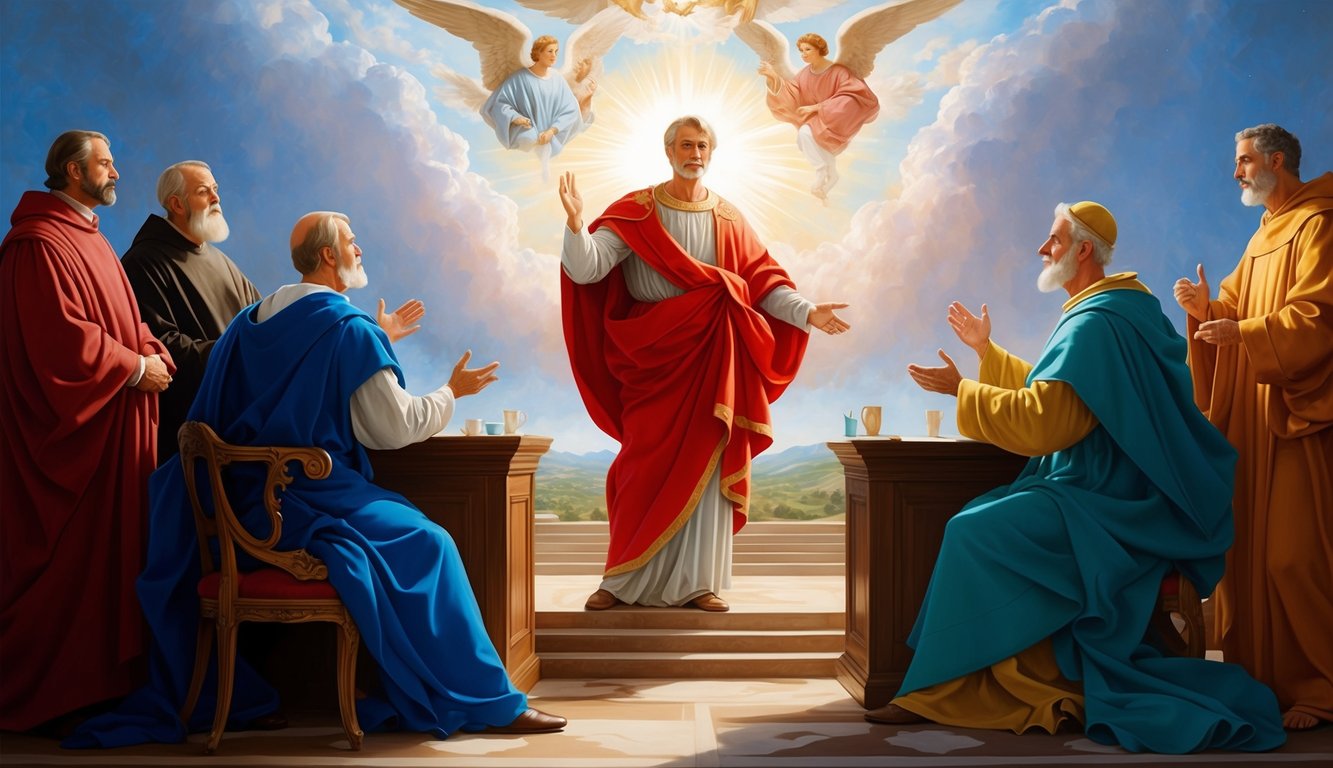Don’t Miss Out On This Unique Astrological Opportunity
Are you tired of spinning your wheels and getting nowhere? Simply put, you’re out of sync: you’re out of alignment with your astral configuration.
But: there’s a kind of map that can help you reclaim your alignment. Think of it as your own personal blueprint to success and happiness: a blueprint that will help you live your most amazing life.
Get started here.
When you think about the story of Lucifer, you might imagine a tale of rebellion in the heavenly realms.
In Christian texts, Lucifer is often depicted as a being who was full of pride and sought to make himself equal to God.
His sinful actions and desire to be like the Creator led to his casting out of heaven.
This transformed him into a fallen angel who roams the earth.
The Bible hints at this dramatic fall through verses and stories, giving you a glimpse into the tension and defiance that led to Lucifer’s downfall.
It suggests that Lucifer was not just any angel but one of prominence before his pride got the better of him.
This rebellion and the subsequent casting out of heaven have intrigued believers and scholars alike for centuries.
As you dive deeper into this story, imagine the heavenly setting where this drama played out.
Consider the impact of this event, not just on Lucifer himself but on the grand narrative of the world according to Christian teachings.
Understanding why Lucifer was cast out can offer insights into themes of pride, power, and divine justice in the Bible.
Biblical Accounts of Lucifer’s Fall
The Bible presents a few distinct perspectives on Lucifer’s fall from grace.
These accounts explore his pride and rebellion against God, shedding light on his transformation from a glorious being to a fallen adversary.
Explore the crucial roles played by Isaiah, Ezekiel, and Revelation in these narratives.
Isaiah’s Testimony
In Isaiah 14, you find a vivid portrayal of Lucifer as the “Morning Star.” This passage describes his ambition to ascend above the clouds and become like the Most High.
Due to this pride, he was cast down to the earth.
Lucifer’s fall is often connected to the king of Babylon.
This connection serves as a metaphor for arrogance and the ultimate fall from power.
The imagery of Lucifer being thrown down is meant to highlight the consequences of pride and selfish ambition.
Ezekiel’s Prophecy
Ezekiel 28 speaks to you about Lucifer’s story through an allegory of the King of Tyre.
In this text, Lucifer is described as a “Guardian Cherub” in the Garden of Eden.
His wisdom and beauty initially set him apart.
However, due to iniquity and pride, Lucifer’s heart turned, leading to his downfall.
He was expelled from the mountain of God.
Here, you clearly see the theme of how absolute power can lead to corruption and eventual ruin.
This narrative uses vivid language to emphasize Lucifer’s exalted status and subsequent judgment.
Revelation’s War in Heaven
Revelation 12:4 details the War in Heaven, where you see the celestial battle between good and evil.
In this dramatic scene, Lucifer, also called Satan, leads a rebellion against God.
The text describes how a third of the angels joined him in this revolt.
Ultimately, Lucifer and his allies were defeated and cast out of heaven.
This account serves to portray the cosmic struggle between divine authority and rebellious forces.
It highlights the consequences of defying divine will and the importance of loyalty to God.
You find this story compelling for its depiction of the eternal battle between light and darkness.
This timeless narrative resonates across cultures, illustrating the triumph of righteousness over defiance.
It reinforces the belief that faith and obedience lead to victory, a concept reflected in 1 John 5:4 meaning, which emphasizes the power of faith in overcoming the world.
The story of Lucifer’s fall ultimately serves as a reminder of the unwavering supremacy of divine justice.
The Nature of Sin and Pride
Sin and pride are key reasons why Lucifer was cast out of heaven.
These elements show how rebellion starts, how pride leads to downfall, and the role of choice in facing temptation.
The Roots of Rebellion
Rebellion begins with the desire to challenge authority.
Lucifer, once an angel, aimed to be equal to God.
This act was against the divine order.
Lucifer’s choice to go against God marked the first sin.
It wasn’t just an action; it was a mindset.
He refused to accept his place and sought more than he was given.
This choice shows how rejecting what’s right leads to sin.
It’s important to recognize that rebellion isn’t just about actions.
It’s about the heart’s attitude.
Pride Before the Fall
Pride played a major role in Lucifer’s fall.
He was proud of his own beauty and wisdom.
This pride made him think he was invincible.
Lucifer believed he was greater than others and even equal to God.
This false belief was his downfall.
Pride distorts perception and makes you lose sight of reality.
The Bible warns repeatedly about pride.
It leads you to act selfishly.
Accepting guidance and recognizing your limits helps prevent pride’s destructive path.
Temptation and Free Will
Temptation tests your ability to choose wisely.
Lucifer had free will, which let him choose his actions.
He could have followed the divine plan but chose otherwise.
Free will is a gift and a responsibility.
It demands careful choices.
By understanding right from wrong, you can resist temptation and its pull.
Temptation can seem enticing, but it often leads to regret.
Knowing that your choices have consequences shapes your understanding of right and wrong.
This awareness helps you choose paths that reflect God’s will, not prideful desires.
Lucifer’s Role and Identity

Lucifer, often associated with themes of light and wisdom, is commonly linked to the portrayal of a fallen angel.
Key aspects of his identity include his titles, his status as a cherub and the Morning Star, and his transformation into Satan.
The Title ‘Lucifer’
The name Lucifer is Latin for “light-bringer” or “morning star,” which highlights a sense of brightness and enlightenment.
Originally, it referred to the planet Venus seen at dawn.
In Christian texts, Lucifer is sometimes viewed as a powerful being who once held a special position in heaven.
Your understanding of the character may depend on various interpretations across texts and traditions.
Some interpretations present Lucifer in a more complex light, beyond just the embodiment of evil.
Cherub and Morning Star
Lucifer’s depiction as a cherub emphasizes his significance in heaven’s hierarchy.
A cherub is a high-ranking angel tasked with important duties like guarding divine realms.
This elevated status reflects why Lucifer was initially seen as a majestic and influential figure.
Being called the Morning Star ties into this celestial role.
It signifies not only beauty and power but also a connection to cosmic cycles.
This connection underscores Lucifer’s importance before his fall from grace.
Transformation into Satan
The transformation from Lucifer to Satan marks a drastic change.
This shift symbolizes the fall from a favored position to becoming the adversary, or The Devil.
As Christianity tells it, Lucifer’s pride and desire for power led to his banishment from heaven.
This fall from grace turned him into Satan, the figure that embodies opposition to divine rule.
His identity as Son of Dawn further enhances the gravity of this transformation, signifying lost potential and the consequences of ambition.
Lucifer’s journey from a cherub to the Fallen Angel serves as a powerful narrative about hubris and its repercussions.
Consequences and Aftermath of the Fall

When Lucifer was cast out of heaven, it had significant effects on both cosmic and earthly realms.
The event changed the balance of creation, influencing humanity and revealing Lucifer’s ongoing legacy.
Expulsion and Cast Down
Lucifer’s expulsion transformed him into a fallen angel.
Once a high-ranking angel, his immense pride led to rebellion against God.
As a result, he was banished, becoming Satan.
This fall took him from the glory of heaven to the depths of the Lake of Fire, symbolizing his new status.
The casting out did not only involve Lucifer himself.
Alongside him, other rebellious angels were expelled, forming a group often referred to as demons.
Their fall marked the beginning of constant moral and spiritual battles in the universe.
Impact on Creation
The fall of Lucifer had a profound impact on Earth and all creation.
His presence on Earth is linked to the story of Adam and Eve in Genesis 3.
Temptation led to their disobedience, introducing sin in the world.
This affected the state of humanity, bringing suffering and separation from God.
Creation itself, initially perfect, now faced decay and pain.
The influence of fallen angels brought chaos to what was once harmonious.
Despite this negative turn, the story established a framework for understanding the spiritual battles between good and evil.
The Legacy of Lucifer
Lucifer’s legacy is one of ongoing influence and conflict.
As Satan, he continues to be a key adversary, challenging God’s creation and plan.
His presence is seen through deception and temptation, driving people away from divine truth.
This legacy has also fostered an awareness of moral choices and the importance of faith.
Stories of fallen angels and their rebellion offer lessons that are relevant in understanding spiritual truths and the challenges faced in life.
The consequences of Lucifer’s fall keep affecting both the physical and spiritual realms, influencing beliefs about good, evil, and redemption.
Lucifer in Theological Discussion and Cultural Representation

Lucifer, often associated with the serpent in Christian theology, has intrigued scholars and theologians for centuries.
This section dives into scholarly interpretations, artistic depictions, and modern symbolism, exploring the varied roles Lucifer plays across different contexts.
Scholarly Interpretations
Theologians and Bible scholars have long debated the reasons for Lucifer’s fall.
Some interpretations suggest that his pride and desire to be like God led to his expulsion from heaven.
Others view him as a representation of the struggle between good and evil.
Latin texts often depict Lucifer as a cautionary tale about the dangers of hubris.
Scholars also examine how these interpretations influence religious teachings and moral lessons.
These scholarly discussions shape our understanding of Lucifer’s role in biblical narratives.
Lucifer in Literature and Arts
Lucifer is a prominent figure in literature and arts, serving as a metaphor for rebellion and free will.
Works like Milton’s Paradise Lost illustrate his complex character, symbolizing both defiance and enlightenment.
This portrayal can be seen in paintings and sculptures from various eras, each reflecting different cultural attitudes toward his story.
The arts often depict Lucifer with a blend of allure and danger, making his image both captivating and cautionary.
These cultural representations highlight how art influences perceptions of Lucifer across generations.
Modern-Day Symbolism
In today’s culture, Lucifer represents more than just a religious figure.
He is a symbol of individualism and questioning authority.
From music to films, his character can embody themes of challenging norms and exploring forbidden knowledge.
For instance, the book “Lucifer Ascending” touches on Lucifer’s use in popular culture, highlighting this shift.
He often symbolizes the anti-hero, capturing curiosity by representing both the rebel and the seeker of truth.
This modern symbolism continues to evolve, influencing both personal beliefs and societal norms.



